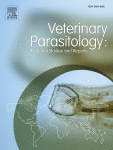Ver ítem
- xmlui.general.dspace_homeCentros Regionales y EEAsCentro Regional Santa FeEEA RafaelaArtículos científicosxmlui.ArtifactBrowser.ItemViewer.trail
- Inicio
- Centros Regionales y EEAs
- Centro Regional Santa Fe
- EEA Rafaela
- Artículos científicos
- Ver ítem
Reduced efficacy of ivermectin and moxidectin against Parascaris spp. in foals from Argentina
Resumen
Macrocyclic lactones are the most widely used drugs for the control of gastrointestinal nematodes of horses in Argentina. Ivermectin and moxidectin are used as broad spectrum anthelmintics and although there are several international reports on the resistance of Parascaris spp., the resistance status of the local nematode population is largely unknow. This report informs a case of suboptimal efficacy to both drugs to control Parascaris spp. in foals in
[ver mas...]
Macrocyclic lactones are the most widely used drugs for the control of gastrointestinal nematodes of horses in Argentina. Ivermectin and moxidectin are used as broad spectrum anthelmintics and although there are several international reports on the resistance of Parascaris spp., the resistance status of the local nematode population is largely unknow. This report informs a case of suboptimal efficacy to both drugs to control Parascaris spp. in foals in central Argentina. In February 2018, routine fecal parasite egg counts showed a moderate-high number of Parascaris spp. eggs (mean = 680 eggs per gram of feces) in foals treated approximately one month before with moxidectin. Upon suspicion of resistance of this parasite to the macrocyclic lactones, 24 of these animals were selected for a fecal egg count reduction test (FECRT). Twelve foals were treated with ivermectin and the remaining 12 animals with moxidectin. Two weeks after treatment, the FECRT was 48.1% and 34.8% for moxidectin and ivermectin respectively (25% of the animals increased the number of eggs in feces after treatment). Five days later, the administration of fenbendazole resulted in a FECRT = 100%. The monitoring of the status of susceptibility or resistance in each establishment is critical for the design of control programs based on rational and sustainable use of anthelmintics.
[Cerrar]

Autor
Cooper, Laura G.;
Caffe, Gabriel;
Cerutti, Julieta;
Nielsen, Martin K.;
Anziani, Oscar Sergio;
Fuente
Veterinary Parasitology: Regional Studies and Reports : 100388 (Available online 20 February 2020)
Fecha
2020-02
Editorial
Elsevier
ISSN
2405-9390
Formato
pdf
Tipo de documento
artículo
Palabras Claves
Derechos de acceso
Embargado
 Excepto donde se diga explicitamente, este item se publica bajo la siguiente descripción: Creative Commons Attribution-NonCommercial-ShareAlike 2.5 Unported (CC BY-NC-SA 2.5)
Excepto donde se diga explicitamente, este item se publica bajo la siguiente descripción: Creative Commons Attribution-NonCommercial-ShareAlike 2.5 Unported (CC BY-NC-SA 2.5)

